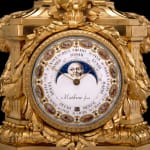Joseph Coteau French, 1740-1812
Literature
Winthrop Kellogg Edey, "French Clocks", 1967, p. 67, illustrating an almost identical clock, the property of the late George Field at Christie's London, 12th June 1893, lot 80, which sold for 199 guineas, 10 shillings to Wertheimer and later entered the Greenberg Collection, New York. Jean-Dominique Augarde, "Les Ouvriers du Temps", 1996, p. 205, pl. 167, illustrating an almost identical clock with additional flanking figures of Study and Geography upon a green marble base, which was delivered for the furnishings of the Michel Palace built by Emperor Paul I at St Petersburg in 1798.
A magnificent Louis XVI gilt bronze striking astronomical vase-shaped pendule à cercles tournants by Claude Mathieu of month duration with superb enamel work by the esteemed enamellist Joseph Coteau signed on the white enamel polychrome painted calendar dial and signed and dated on its reverse Coteau/..i le 3 1774 Mathieu fecit and also signed on the backplate C. Mathieu à Paris, the calendar dial centred by a rolling moon phase, outer concentric rings for the days of week and months of year with their relevant number of days, a date aperture with silvered ring at 6 o'clock and a superb outer zodiac ring painted in gilt-framed roundels interspersed by green enamel jewelling. The urn carrying two revolving chapter rings with Roman hour and Arabic minute white enamel chapter disks indicated to by means of a brilliant-set star (for the minutes) and the upward curled tail of a salamander (for the hours). The chapter rings revolving by means of an indirect bevel gear system to the going barrel movement below with anchor escapement, (lacking crutch piece) and count wheel strike on a bell within the base. The magnificent urn-shaped case with a gadrooned and berried laurel leaf top and handles festooned with fruit-laden foliate swags, the fluted sconce base supported on a rectangular pedestal with outset fluted pilasters and rams' heads to the sides, draped with ribbon-tied swags of berried laurels and set with a circular calendar dial, the whole on a white marble base with outset angles on gilt bronze bun feet and a purpose made velvet-lined ebonised stand
Paris, dated 1774
Height 56 cm, width across the plinth 25 cm, depth 21.5 cm.
In addition to the above another very similar clock from the collection of Charles de Bestegui, Château du Groussay, was sold by Sotheby's 3rd June 1999, lot 868. A further clock with a replaced plain dial by Droz was sold from Le Pavillon Chougny, Christie's London, 9thDecember 2004, lot 374 while another example without the calendar dial below, but likewise with a movement by Mathieu, is illustrated in Pierre Kjellberg, "La Pendule Française du Moyen Age au XXe Siècle", 1997, p. 98.
JOSEPH COTEAU (1740-1812). FRENCH
Painted enamel and porcelain dials became increasingly popular during the reign of Louis XVI, reaching perfection in the hands of Joseph Coteau and Gobin Etienne (known as Dubuisson). Coteau was born in Geneva, Switzerland but is known to have practised his specialised craft in Paris. During his maturity he was established at Rue Toupee in the parish of Sant-Andre-des-Arts, where he remained until his death. At the age of 23 he produced the dial for a musical clock by Daille, horologer to Madame la Dauphine, 1763(Wallace Collection, London). Coteau attained such repute that he only ever supplied to the most eminent horologists, including Antide Janvier (1751-1835), Robert Robin (1742-1809) and Ferdinand Berthoud (1727-1807). He is also known to have decorated pieces of jewellery.
Coteau clock dials have a characteristic style, due as much to their superior quality as to their subject. His most distinct decoration consisted of delicate numerals with small garlands of flowers but more usually with signs of the zodiac, each element worked as an individual miniature. Other dials had little or no extra ornament except for the classical Louis XVI style numerals, such as his dial for the Avignon Clock, 1771 (Wallace Collection, London), with the movement by Delunesy and elaborate gilt bronze case sculptured by Louis-Simon Boizot (1743-1809) and executed by Pierre Gouthiere (1732-C.1812). At other times Coteau supplied decorative bands to accompany clock cases, such as an enamel frieze around a vase adorning one of Robert Robin's elaborate clocks, c.1780 (Wallace Collection, London). The band, painted in grisaille, depicts the seasons personified by infants playing and is interspersed by four cameo heads. A similar clock was supplied to Marie Antoinette for Chateau St. Cloud. Decorative dials and their accompanying complex quality movements fell in demand during the Revolution, however Coteau was patronised by the new government to create a number of Republican ten hour dials.
It appears that Coteau never enamelled watches or small scale pieces but specialised in larger works, which were technically more complex due to shrinkage during firing. The techniques required a high degree of skill to achieve a perfect finish. Coteau experimented with various polychromes, producing a blue that was so rare and complex that few if any of his contemporaries managed to copy. The enamel paint was applied with a brush onto a copper plate and the various colours vitrified one by one in a muffle kiln. The decoration was then enhanced by delicate gilding, which after firing resulted in a matt finish, the gilding was finally burnished to restore its metallic brightness.
Coteau dials are extremly rare, they are sometimes "secretly" inscribed on the reverse, in either pen or bruch. In addition to their scarcity and their supreme quality, his dials and enamel plaques only accompanied the most complex quality mechanisms. For these reasons his work is a tru prize and significantly enhances the value of any clock. Examples of his work can be found in a number of European museums, including Mobilier National, Musee des Arts Decoratifs, Paris; Carnavelet Museum, Dijon Museum, and in London at the Wallace Collection and Victoria and Albert Museum.
Copyright by Richard Redding , Zurich, all rights reserved.



